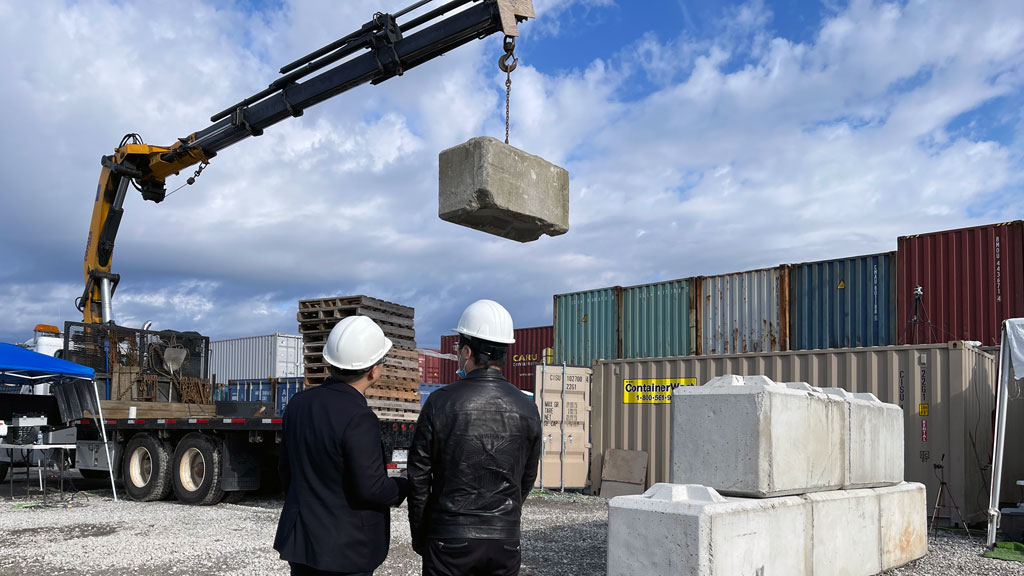An operator places a small aerial drone on the ground and punches a few commands into a control panel. The device comes alive and quickly ascends into the sky over the construction site.
As the flying robot passes overheard, its camera digitally maps obstacles, equipment, material, vehicles and people on the site to create a computer-generated digital twin or simulation.
Below, a truck-mounted crane equipped with circuitry, sensors, robotics and a telescopic boom is using the information to lift a large concrete block into place and begin building a wall.
Welcome to the future of construction with heavy equipment AI.
The demonstration took place at a site in Richmond, B.C., where researchers from the Smart Structures Lab at the University of British Columbia (UBC) showed how artificial intelligence (AI) technology can be used with robotics to do basic tasks such as lifting and moving objects.
Using the technology, UBC researchers can now transform construction heavy equipment such as cranes, excavators and forklifts into smart machines powered by AI.
“Our smart construction robots are able to recognize objects, performing detailed scans of structural components for quality assurance,” explains Tony Yang, a professor in the department of civil engineering at UBC. “They can precisely place objects onsite and check against a computer model to ensure they are building according to plan.
“They can make autonomous decisions such as navigating around obstacles or instantly stopping work to protect a worker who is in danger.”
Safety is paramount
For example, if a robot is asked to build a wall and senses an unexpected obstacle or person in a danger zone, it can decide how to navigate around the hindrance and complete its task – all without needing a human operator.
“It understands this concrete block needs to go here and it has the ability to understand what needs to be done and what the machine needs to do,” says Yang.
“It’s very precise. Safety is number one, so on the construction site we want to make sure our big hydraulic machines don’t cause any construction safety hazards. We proved it to them in real time.”
A switch enables an operator to turn off equipment in the event there are any problems.
Yang says conventional onsite construction requires extensive labour and time. But robotic sensors can check a structural component 1,000 times per second and will not tire or make judgment errors.
With the world’s population growing rapidly and the need for housing escalating, Yang and his team set out to develop the next-generation technology to make construction sites smarter.
“We invested in virtual reality, Building Information Modeling, robotic construction and digital twin technology and over the last six or seven years we’ve developed technology to do AI for recognition purposes. The robots can do autonomous inspections to understand the site.”
Doing the work…autonomously
Researchers also began using AI for decision-making and figuring out the best way to do assembly work. They developed a control algorithm to regulate and operate the heavy equipment. A module and sensors are installed in the heavy equipment so it can do the work autonomously.
“Every construction machine now becomes a robot,” says Yang. “The crane, the excavator, everything becomes smart now. Anything that you can do with a regular machine, it can do. We just make them smart. Usually, you need a human to operate the machine. Now it is doing it by itself.”
When materials arrive on a site, robots can do detailed scans against required specifications for quality assurance, compare components with computer models, and start assembling onsite.
Yang says using heavy equipment AI the machine would be operated much like a driverless vehicle.
For the recent demonstration project, it took three weeks to modify the heavy equipment and get it working properly. More than 80 construction industry stakeholders attended the preview.
The technology is expected to improve productivity and safety as humans can get distracted on a job and make mistakes. Meanwhile, injuries from repetitive tasks like bricklaying can be reduced.
Yang says the technology is not to replace workers but is more about increasing productivity and making worksites safer.
In remote areas, for example, where it may be difficult to send a crew, a machine could be programmed to do the work, get dropped onsite, and run continuously.
“In the past, they’d have to stand there and do it,” notes Yang. “Now they can assign jobs. They go from really doing the work to being manager. And the manager can now manage more sites. I would think the crane operator would be the manager and they assign jobs and then the machine will carry it out.”
The UBC team is now working with Rogers to make sure everything is compatible on the 5G network.
“We are creating a cloud-based management platform so workers in Toronto can monitor a site in southeast Asia in real-time and see how the robots are working,” says Yang.









Recent Comments
comments for this post are closed